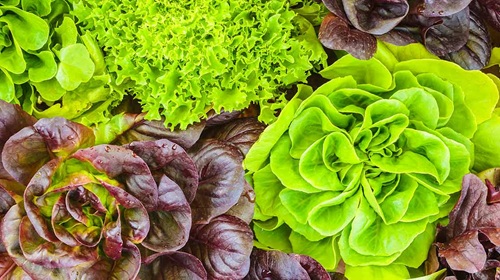Jun 18th 2025
How to Grow Lettuce Indoors: Guide For Hydroponic Growing
Nothing compares to the flavor of freshly picked greens right out of the garden. That is a spring-through-fall delight for most of us. On the other hand, those who enjoy salads can grow lettuce indoors throughout the winter. Even urban gardeners can grow a consistent supply of their favorite greens on a windowsill or under grow lights, depending on the amount of sunlight available. Let's go over how to cultivate lettuce indoors.
5 Steps to Grow Lettuce Indoors
Step 1: Choose a Location
If you want to plant lettuce in natural light, you must have a south-facing window since lettuce need full sun to grow well. Since most of us don't have sunlight in our homes for 12 hours every day, a grow light is a great alternative. For cultivating small lettuce crops, tabletop grow light setups are ideal. More growing trays will fit in larger light gardens. Additionally, the place you have chosen ought to be secure. Choose a location that is out of reach of hungry, naughty pets and away from sources of heat and cold drafts.
Step 2: Choose a Structure
The best containers are level, reasonably shallow, and have adequate drainage. Hydroponic towers are also great for growing lettuce – since water is recycled up and down the tower, you don’t have to worry about drainage at all. Other choices include a multi-cell seed-starting system or plastic pots that range in size from 4" to 6". Additionally, you can recycle takeout dishes or produce containers, some of which have clear coverings that are useful for starting seeds.

Certain types of seeds are more suited for indoor cultivation than others. Seek out loose-leaf types including Black-Seeded Simpson, Tom Thumb, and Baby Oakleaf. Certain types, like Arctic King, Winter Marvel, and Winter Density, are known to thrive in winter light. Other salad bowl staples like spinach, mesclun, and arugula are all worth trying to produce. Steer clear of head lettuces, which are challenging to cultivate indoors. Other loose-leaf lettuce varieties include butterhead, oakleaf, and lollo rosso.
Choose the seeds you wish to plant. You have the option of selecting your own kinds or purchasing mixed packets of salad leaf seeds. At this time, you may choose some non-lettuce salad greens as well including beetroot, spinach, mizuna, mustard, red kale, pak choi, sorrel, rocket, and spinach.
Step 3: Germination
Different substrates can be used for hydroponic germination including coco noir, perlite and rockwool. Moisten your substrate so that it’s nice and damp and plant your seeds. We like to plant 2 to 3 lettuce seeds to maximize our germination rates. However, a rockwool cube can only accommodate one mature lettuce plant at a time, so you’ll want to remove extra seedlings from the cube before transferring to your hydroponic system. After seed planting, apply a thin layer of vermiculite over the planting holes. Vermiculate has excellent water retention properties and will help you seeds from drying out.
Lettuce germinates quickest around 75 to 80 degrees Fahrenheit. As a cold weather crop however, lettuce can germinate as low as 55 to 60 degrees (although it will take a little longer). Cover them with a humidity dome or plastic wrap to keep them moist. Look for sprouts every day. Move seedlings under a germination light as soon as sprouts start to show and space the seedlings about an inch apart. Don't overwater the seedlings, but keep them damp.
Step 4: Transferring Seedlings and Introducing Nutrients
Because of their fragility, lettuces need special care when grown indoors. Lean, yellowed plants are light-starved; your seedlings should appear healthy and green. Seedlings can be transferred to the hydroponic system when two true leaves have formed. The first two “leaves” you see or not true leaves, but they are called cotyledons. Wait until two more leaves form (four “leaves” total), and you see roots protruding from the bottom of the rockwool cube.

Once your seedlings have been transferred, you’ll want to begin introducing nutrients. Hydroponic nutrients should be mixed into your reservoir tank, at the proper dilution ratio. Our A & B hydroponic nutrients for example, have a dilution ratio of 15ML per gallon. Be sure to push your seedlings all the way to the bottom of the net pot, to ensure they’ll receive the nutrient solution properly.
Step 5: Harvest
Three to four weeks after transferring seedlings, indoor lettuce should grow to a harvest height of roughly 6 to 10 inches and you can begin harvesting. Starting with the outer leaves, trim each leaf at the base of the plant, about an inch from the base of the plant. Let the remaining leaves continue to grow and you can continue to harvest. Early in the morning, when the leaves are at their tastiest, is the ideal time to harvest lettuce. Plants will produce more leaves if they are harvested sparingly and frequently.
Lettuce spoils easily, so don't cut more than you need. When the harvest is over, sow a new batch of seeds.
Management and Care
In hot, dry conditions, lettuces may begin to blossom (bolt), which turns the leaves bitter. During the summer, sow seeds on cooler days or in the nights when the temperature drops since hot weather can also hinder seed germination.
You can have a fresh, continuous supply of salad leaves all year round by growing loose leaf lettuce and utilizing the "cut and come again" harvesting method described above. Take micro-harvests from multiple plants, snipping the outer leaves while leaving the interior leaves to grow, as opposed to harvesting the entire plant when it is completely grown. This way, your plant will continue to grow and you can come back and harvest again.




